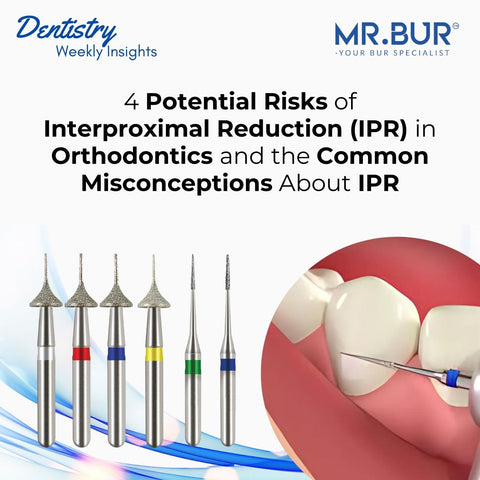In orthodontics, achieving an ideal alignment between upper and lower arches is essential for both functional and aesthetic outcomes. Bolton discrepancy, a mismatch in the tooth size ratio between the upper and lower arches that makes it difficult to achieve a harmonious bite and alignment, is one of the major challenges that dentists face. Fortunately, Interproximal Reduction (IPR) offers a precise and minimally invasive solution to manage these discrepancies effectively. This article explores Bolton discrepancy, the role of IPR in addressing it, and best practices for using IPR burs and strips to enhance orthodontic treatment outcomes.
Understanding Bolton Discrepancy in Orthodontics
Bolton discrepancy, a term named after orthodontist Wayne A. Bolton, describes a tooth size mismatch between the upper and lower arches. This discrepancy can result in improper occlusion, alignment challenges, and difficulty achieving an aesthetically pleasing smile.
Types of Bolton Discrepancy
There are two primary types of Bolton discrepancy, each affecting the overall alignment of teeth differently:
- Overall Bolton Discrepancy: This is a mismatch in the total width of all upper teeth relative to all lower teeth, affecting overall bite and alignment.
- Anterior Bolton Discrepancy: Involves only the six anterior teeth (canine to canine), impacting the aesthetic relationship between the front teeth, which is particularly important for patients focused on the cosmetic aspect of their smile.
Understanding the type and extent of the discrepancy is essential for determining the appropriate orthodontic approach, often involving IPR as a space-creating technique.
3 Causes of Bolton Discrepancy
Bolton discrepancy can arise from several factors, including genetics, tooth size variations, and arch length discrepancies. Common contributing factors include:
- Genetic Tooth Size Variations: Individuals may naturally have larger or smaller teeth on one arch, causing misalignment.
- Missing or Peg-Shaped Teeth: Missing teeth or unusually small teeth can alter the natural tooth size ratio, impacting the balance between arches.
- Arch Length: Differences in arch size or shape can lead to space discrepancies, further complicating alignment.
Assessing Bolton Discrepancy: The Bolton Analysis
The Bolton Analysis is a key diagnostic tool used by orthodontists to measure tooth width ratios and determine if a Bolton discrepancy is present. This analysis helps guide treatment planning by quantifying the mismatch and determining the required space adjustments.
Bolton Analysis Procedure
- Tooth Measurement: The width of each tooth is measured using calipers or digital imaging software.
- Calculating Ratios: The measured widths are used to calculate the ratio of upper-to-lower tooth size, comparing it to ideal ratios established by Dr. Bolton.
- Clinical Interpretation: Depending on the results, orthodontists determine the need for treatments such as IPR, extractions, or restorations to achieve an optimal tooth size ratio.
How Interproximal Reduction (IPR) Addresses Bolton Discrepancy
Interproximal Reduction (IPR) is a precise technique involving the removal of a small amount of enamel from the sides of teeth, creating space without extractions. By adjusting tooth width in a controlled manner, IPR can help balance the tooth size ratio, particularly useful for Bolton discrepancies in crowded cases.
Benefits of Using IPR for Bolton Discrepancy
- Non-Invasive Alternative: Unlike extractions, IPR is conservative, minimally affecting tooth structure.
- Space Creation: IPR provides the needed space to align teeth more effectively.
- Improved Aesthetic Balance: IPR offers subtle tooth width adjustments, achieving a more harmonious appearance between the upper and lower teeth.
Clinical Application of IPR in Managing Bolton Discrepancy
Orthodontists use IPR strategically to correct Bolton discrepancies without compromising tooth integrity. By employing calibrated IPR burs, like Mr. Bur’s One Slice IPR Kit, dental professionals can achieve consistent enamel reduction with minimal risk to the tooth’s structure.
Step-by-Step IPR Process for Bolton Discrepancy Cases
- Initial Planning and Measurement:
- Use Bolton Analysis results to assess the amount of space required for each arch.
- Plan the IPR procedure with calibrated IPR burs to achieve specific enamel reductions, such as 0.3mm or 0.5mm, for controlled space creation. For finer adjustments, use IPR strips that can achieve reductions between 0.08mm to 0.16mm, allowing for a more tailored approach based on individual patient needs.
- Using the Right IPR Bur and Strip for Precision:
- Mr. Bur One Slice IPR Kit provides pre-calibrated burs designed to create precise 0.3mm-0.5mm gaps in a single slice, removing the need for constant measurement and ensuring balanced reduction without excessive enamel removal.
- For more delicate adjustments, Mr. Bur IPR Strips are available, allowing for reductions between 0.08mm to 0.16mm.
- Performing IPR with Controlled Pressure:
- Maintain gentle pressure during IPR to minimize discomfort and protect the dentin.
- Final Adjustment and Check:
- After IPR, use calipers or digital imaging to verify the corrected tooth width ratio.
- Ensure all interproximal surfaces are smooth and check for any sharp edges to enhance patient comfort.
Best Practices for Using IPR to Correct Bolton Discrepancy
Implementing best practices can ensure successful outcomes for Bolton discrepancy corrections:
- Use Calibrated Burs: Using calibrated burs, such as those in Mr. Bur One Slice IPR Kit, ensures consistency in enamel reduction without the need for constant measurement.
- Educate Patients on Oral Hygiene: Proper cleaning of new interproximal spaces is crucial to prevent plaque buildup and maintain results.
- Monitor Progress: Regular check-ups post-IPR help monitor tooth alignment and ensure that the Bolton discrepancy correction is proceeding as planned.
Case Studies: Bolton Discrepancy Corrected with IPR
Sharing real-life case studies can help dental professionals understand the benefits of IPR in correcting Bolton discrepancies. Here are two scenarios demonstrating successful outcomes:
- Treatment involved slight IPR in the anterior region to balance tooth proportions.
- After orthodontic alignment, the patient achieved an aesthetically balanced smile with improved bite alignment.
Case 2: Severe Overall Bolton Discrepancy:
- Due to a more pronounced discrepancy, IPR was performed across several posterior teeth.
- Post-IPR, orthodontic treatment achieved proper alignment and a functional occlusion.
Alternatives to IPR for Addressing Bolton Discrepancy
In cases where IPR may not be suitable or sufficient, alternatives can be considered:
- Restorations (Veneers or Composite Bonding):
When a Bolton Discrepancy results from undersized or disproportionately narrow teeth, restorations like veneers or composite bonding can increase the width of specific teeth to achieve balance. This approach is particularly beneficial for patients with excess spacing or a "gapped" appearance. Veneers can be used to create a consistent, harmonious smile by widening small anterior teeth, such as peg laterals. Composite bonding, on the other hand, offers a minimally invasive option that can quickly adjust tooth width without significant enamel reduction. Both veneers and bonding can be color-matched to the patient's natural teeth, providing a seamless and esthetically pleasing solution. - Extractions for Severe Discrepancies:
In cases of severe Bolton Discrepancy, where there is a substantial difference in tooth size that cannot be managed with IPR alone, extractions may be recommended. Extractions are often chosen in situations of severe crowding or pronounced size discrepancies, allowing for optimal alignment and bite correction. Typically, premolar extractions are considered to create the necessary space for realignment, especially when attempting to reduce the dental arch size. Extractions are generally recommended with careful treatment planning and in conjunction with orthodontic appliances to close gaps and ensure a balanced occlusion.
Maintaining Post-IPR Results
After IPR, ongoing maintenance is essential for optimal results:
- Interdental Cleaning: Encourage patients to use interdental brushes or floss to prevent plaque buildup in reduced spaces.
- Fluoride Treatments: Fluoride varnishes or toothpaste strengthen enamel and reduce sensitivity risk.
Regular Follow-Ups: Routine check-ups allow monitoring of tooth alignment and any potential post-IPR issues.
Discover More:
1. Types of Braces in Orthodontics and Tooth Preparation: Using IPR Burs for Optimal Outcomes
2. Understanding and Reducing Black Triangles in Dentistry: When to Use IPR
3. One Slice IPR Kit vs. Traditional Tools: Enhancing Interproximal Reduction
4. Step-by-step guide to Interproximal Bur Technique: The bur used for IPR
At Mr. Bur Australia, we pride ourselves on exceeding expectations and continually improving to meet the evolving needs of our customers.
Diamond Burs, Carbide Burs, Surgical & Lab Use Burs, Endodontic burs, IPR Kit, Crown Cutting Kit, Gingivectomy Kit, Root Planning Kit, Orthodontic Kit, Composite Polishers, High Speed Burs, Low Speed Burs
Subscribe our newsletter now!






